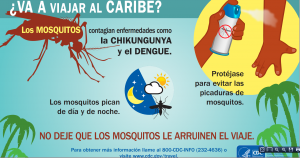Health authorities from the Dominican Republic held weekend social mobilizations in five of the hardest hit provinces plus the National District in an effort to get the chikungunya and dengue fever situation under control on the Caribbean island, according to a news release June 7 (computer translated).

Health minister, Dr. Freddy Hidalgo Núñez said the social awareness will help educate the public about the mosquito vector of these two viruses, Aedes aegypti, and the necessity to remove mosquito breeding sites.
“We will continue to work tirelessly in these social mobilizations because we want people to abide by the guidelines on how to rid their yards and their homes of the mosquito that causes dengue disease and only with the help of people can do,” Dr. Hildalgo Núñez noted.
Health professionals taught citizens about the vector and the characteristics of chikungunya and dengue, keeping the messages clear to avoid confusion. Banners, pamplets and the use of loudspeakers were used in the public education effort.
In addition, officials recommended the use of mosquito nets, the spread of chlorine tanks and periodic spraying. The interventions took place at Hato Mayor, Santo Domingo, Independencia, the National District and San Cristobal, where half of the chikungunya cases have been reported.
As of June 6, the Pan American Health Organization (PAHO) reports nearly 53,000 confirmed and suspected chikungunya cases on the country occupying the eastern two-thirds of Hispaniola.
Dominican Republic health officials say chikungunya causes fever and severe joint pains. Symptoms include muscle aches and pains, headaches, nausea, fatigue and rash. Symptomatic treatment is based acetaminophen, fluid and rest. 98 percent of people infected are treated on an ambulatory basis. For more infectious disease news and information, visit and “like” the Infectious Disease News Facebook page

